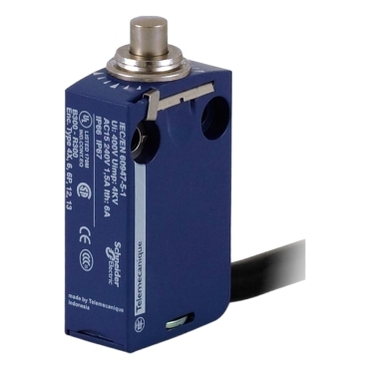-
×
 XCMD2110L1 | Limit switch, Limit switches XC Standard, XCMD, metal end plunger, 1NC+1 NO, snap, 1 m
1 × EGP2,504
XCMD2110L1 | Limit switch, Limit switches XC Standard, XCMD, metal end plunger, 1NC+1 NO, snap, 1 m
1 × EGP2,504
Subtotal: EGP2,504
EGP2,613EGP4,930 (-47%)
Telemecanique XS630B1NAL2 | Inductive proximity sensors XS, inductive sensor XS6 M30, L62mm, brass, Sn15mm, 12…48 VDC, cable 2 m
Telemecanique XS630B1NAL2 | Inductive proximity sensors XS, inductive sensor XS6 M30, L62mm, brass, Sn15mm, 12…48 VDC, cable 2 m
The Telemecanique XS630B1NAL2 is a premium inductive proximity sensor designed for a wide range of industrial applications. This model is known for its reliability, precision, and ability to detect metal objects without physical contact, making it essential in sectors such as manufacturing and automation. But what exactly sets it apart from other sensors, and why is it widely used?
Telemecanique, a trusted brand within the Schneider Electric group, has a long-standing history of delivering high-quality industrial automation products. Known for innovation, durability, and cutting-edge technology, Telemecanique has become synonymous with reliability in automation and control products.
Their product range spans sensors, switches, and other components that streamline automation processes, with the XS630B1NAL2 being one of their standout proximity sensors.
The XS630B1NAL2 is an inductive proximity sensor, meaning it can detect metal objects within its sensing range without any physical contact. Here are the key technical specifications:
These features make the XS630B1NAL2 suitable for rugged environments where durability and precision are paramount.
The versatility of the XS630B1NAL2 means it is used in a variety of industrial settings:
Why should industries opt for the XS630B1NAL2? Here are some compelling reasons:
Industrial automation is all about efficiency, and the XS630B1NAL2 plays a key role in that. By providing fast, accurate, and non-contact detection of metal objects, it ensures that machinery operates smoothly, reducing downtime and enhancing overall production speed.
In addition, it reduces wear and tear on equipment since it doesn’t require physical contact with the objects it detects, which ultimately lowers maintenance costs.
Reviews
There are no reviews yet.